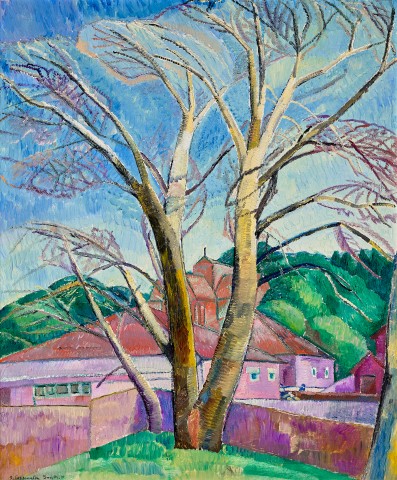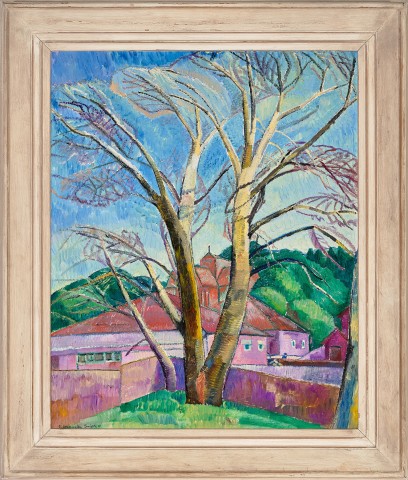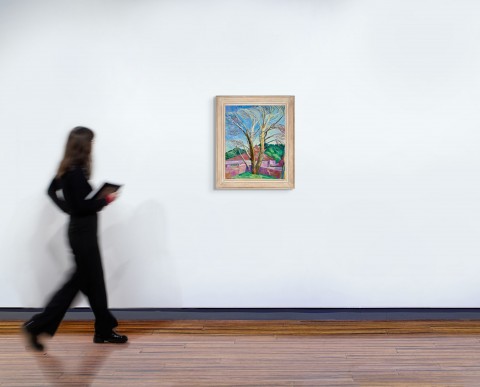THE WINTER TREE, TURRAMURRA, 1935
GRACE COSSINGTON SMITH
oil on pulpboard
61.0 x 51.0 cm
signed and dated lower left: G. Cossington Smith, 35
signed and inscribed verso: Winter tree/ G. Cossington Smith
inscribed with artist’s name on old label attached verso
Toorak Gallery, Melbourne, 1969
Private collection, Melbourne, from December 1969
Deutscher~Menzies, Melbourne, 26 November 2003, lot 16
Private collection, Melbourne
Society of Artists Annual Exhibition 1935, Education Department Gallery, Sydney, 6 September – 4 October 1935, cat. 160 (as ‘The Winter Tree’)
Grace Cossington Smith, Art Gallery of New South Wales, Sydney, 15 June – 15 July 1973, cat. 40, and touring to: Queensland Art Gallery, Brisbane, 6 September – 4 October 1973; Western Australian Art Gallery, Perth, 6 December 1973 – 2 January 1974; Art Gallery of South Australia, Adelaide, 11 January – 10 February 1974; and National Gallery of Victoria, Melbourne, 26 March – 28 April 1974 (label attached verso, as ‘The winter tree’)
Grace Cossington Smith: A Retrospective Exhibition, National Gallery of Australia, Canberra, 4 March – 13 June 2005, then touring to: Art Gallery of South Australia, Adelaide, 29 July – 9 October 2005; Art Gallery of New South Wales, Sydney, 29 October 2005 – 15 January 2006; and Queensland Art Gallery, Brisbane, 11 February – 30 April 2006 (label attached verso, as ‘The winter tree’)
Thomas, D., Grace Cossington Smith, Art Gallery of New South Wales, Sydney, 1973, cat. 40, pp. 8, 37 (illus.), 65 (as ‘The winter tree’)
James, B., Grace Cossington Smith, Craftsman House, Sydney, 1990, p. 102
Hart, D., Grace Cossington Smith, National Gallery of Australia, Canberra, 2005, pp. 52, 53 (illus.), 178 (as ‘The winter tree’)
Sketch for ‘The winter tree’, c.1935, pencil on paper, 35.6 x 25.4 cm, leaf 18 recto, from the ‘Sketchbook of people, scenes, groups and draft advertisements’, in the collection of the National Gallery of Australia, Canberra
Presbyterian Church, Turramurra, watercolour, exhibited in Grace Cossington Smith, Grosvenor Galleries, Sydney, 23 July – 4 August 1928, cat. 40
GRACE COSSINGTON NEW SATURDAY NIGHT.jpg
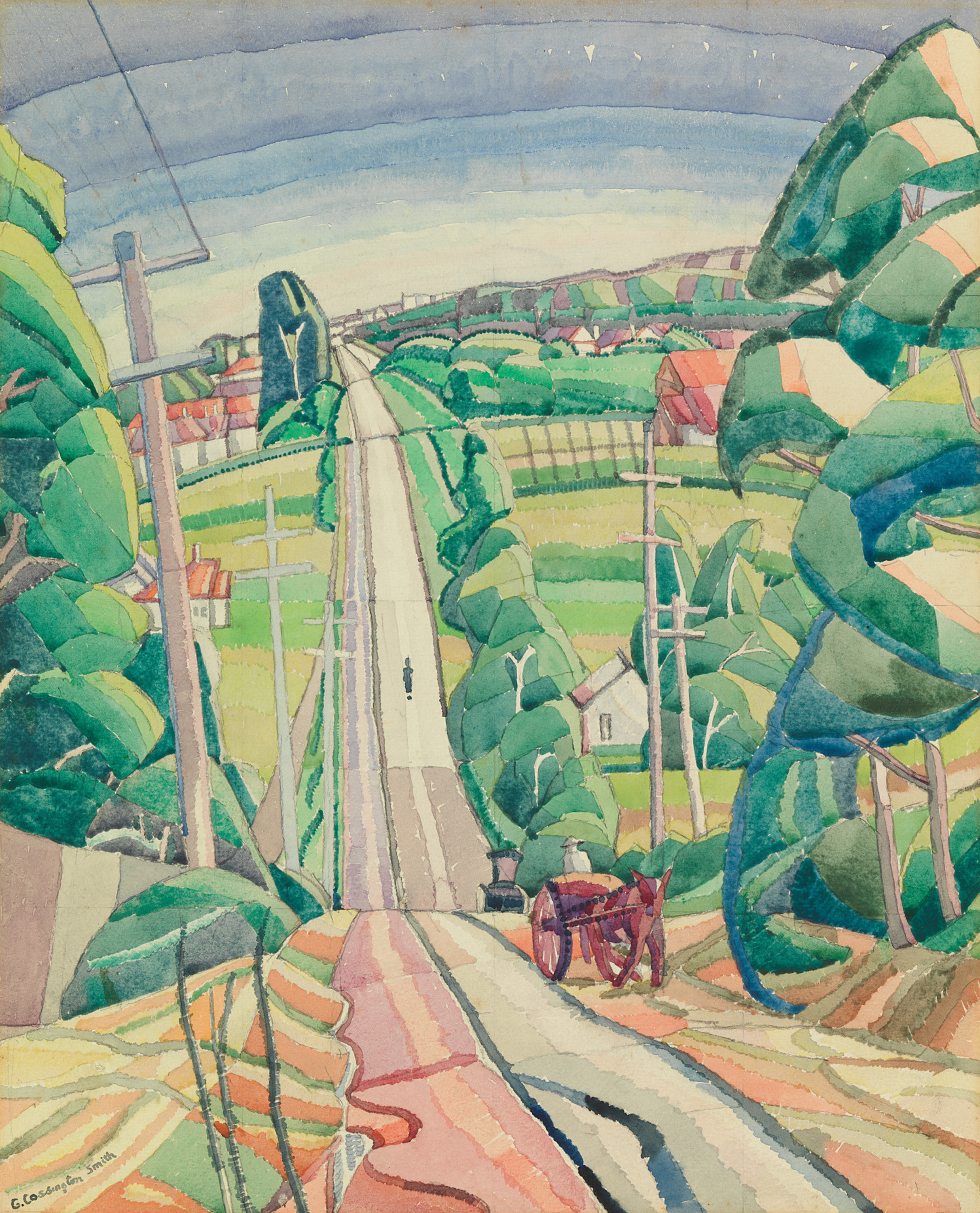
In the mid-1930s, the leading modernist artists in Australia were women: Clarice Beckett in Melbourne, with Margaret Preston, Grace Crowley and Grace Cossington Smith in Sydney. Whilst Preston may have been the most visible due to her lectures, essays and self-publicity, Cossington Smith was even more retiring than Beckett – although, as leading curator Deborah Edwards observed, Smith was ‘the most profoundly inventive landscapist of all Australian moderns until Nolan.’1 Like Beckett with her home suburb of Beaumaris, Smith found a huge range of possibilities for her subjects in the streets surrounding her house in Kuringai Chase Avenue, Turramurra, such as Eastern Road, Turramurra, c.1926 (National Gallery of Australia); Wonga Wonga Street, Turramurra, c.1930 (Art Gallery of New South Wales); Landscape at Pentecost, 1929 (Art Gallery of South Australia); and House with trees, c.1935 (private collection) which features the mansion at 5 Boomerang Road. Similarly, The winter tree, Turramurra, 1935 depicts the view from Gilroy Road looking onto the rear of St Margaret’s Presbyterian Church.
By 1935 Smith was well established as an artist of note, having mounted major solo exhibitions in Sydney and London. Originally studying alongside Roy de Maistre, Roland Wakelin and Constance Tempe Manning at Anthony Dattilo-Rubbo’s atelier in Sydney, she is recognised for having painted Australia’s first modernist painting, The Sock knitter, 1915 (Art Gallery of New South Wales). On leaving art school, she painted in isolation at the family home, although in 1926 Ethel Anderson, whose husband was Secretary to the Governor of New South Wales, moved in around the corner. Upon visiting Smith’s backyard studio with her daughter, Anderson, already an enthusiast of modern art, was both stunned and delighted: ‘My mother’s eyes were sparkling with excitement… [saying to Smith] ‘With your unique brushstroke, with your grasp of colour, you may be about to give an expression to a quality in life, more moving than beauty alone, more intimate than infinity. You may find a fourth-dimensional emotion, as yet unfound, un-named.”2 Smith was likewise stunned, and overjoyed that for once her work was taken seriously, and between 1927 and 1930, she went on to produce her now-iconic images of the Sydney Harbour Bridge under construction. Following the death of her mother in 1930, Smith’s work became notably more introspective, although this period nevertheless also witnessed the creation of one of this country’s undisputed landscape masterpieces, namely Sea wave, 1931 (National Gallery of Australia), and the dramatic Black mountain, 1931 (private collection).
GCS TREES (LOW RES PLACEHOLDER ONLY)-topaz-upscale-2x.jpg
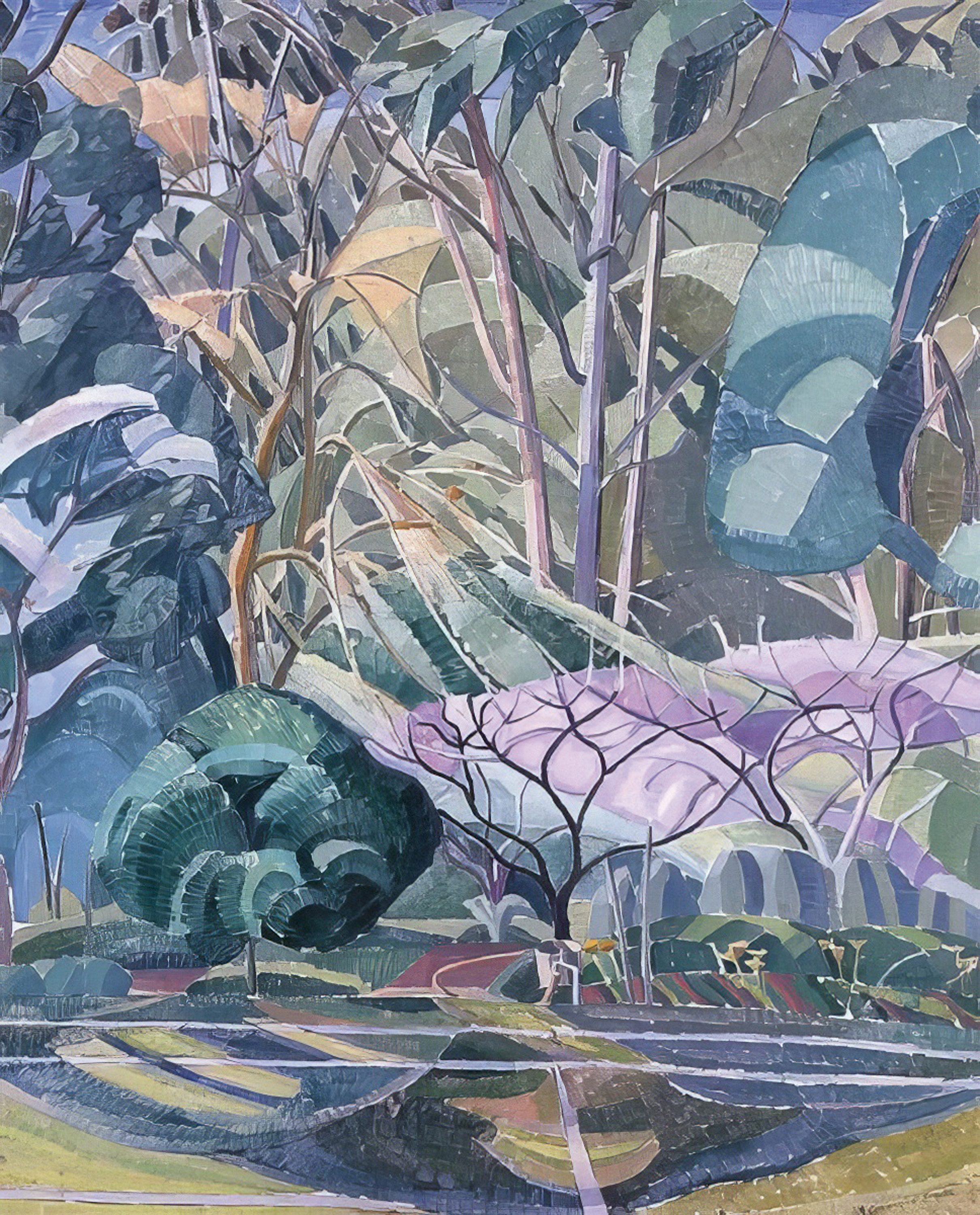
Smith’s work was an amalgam of Cézanne in analysis and Van Gogh in liberation of colour, but another key influence was Beatrice Irwin’s book New science of colour (1915) which Smith laboriously transcribed by hand to truly gain the essence of her theories. Creating her own colour chart based on Irwin’s system where ‘there were three natural divisions – physical, mental and spiritual – each with subdivisions of sedative, recuperative and stimulative colour… for Cossington Smith, among the most important aspects of Irwin’s writing was the need to go beyond optical vision and to consider the effect that colour has on us.’3 An examination of Smith’s studies of trees over time reveals the veracity of this statement. For example, Trees, c.1927 (Newcastle Region Art Gallery) which features the tangled bush beyond the family’s tennis court, is demarcated into agitated zones of greens, lavender and blue capturing the light spilling through the canopy in a multitude of small brushstrokes applied in ‘firm, separate notes of clear, unworried colour.’4
The winter tree, Turramurra, 1935 takes a similar approach with the tree centring the composition, its organic bend contrasting with the meticulous architectonic lines of St Margaret’s church, dedicated in 1927.5 Apart from Smith’s distinctive brushwork and use of colour, it stands true to Smith’s statement that ‘I always painted what was around me, what was there… I didn’t like to make things up.’6 Being winter, the deciduous tree’s branches are bare, but the chill evident in the ice blue of the sky is somewhat tempered by the warm pink used for the church buildings. The surface is matt which identifies it as being alla prima – ‘paint which is applied once and not touched again.’7 Indeed, Smith was renowned for never revising her brushstrokes and The winter tree, Turramurra thus appears as fresh today as when first painted ninety years ago.
1. Edwards, D., ‘Landscapes of modernity 1920s-40s’ in Sydney moderns: art for a new world, Art Gallery of New South Wales, Sydney, 2013, p. 221
2. Foott, B., Ethel and the governor’s general, Rainforest Publishing, Paddington, NSW, 1992, p. 128 – 30
3. Hart, D. (ed.), Grace Cossington Smith, National Gallery of Australia, Canberra, 2005, p. 28
4. Grace Cossington Smith, cited in Thomas, D. R., Grace Cossington Smith, Art Gallery of New South Wales, Sydney, 1973, p. 6
5. St Margaret’s is now Sungrak Baptist Church.
6. Grace Cossington Smith, cited in Duigan, V., ‘A portrait of the artist at 90’, The National Times, Canberra, 7 – 13 March 1982
7. Proctor, T., ‘Modern art in Sydney’, Art in Australia, 15 November 1938, 3rd series, no. 73, p. 28
ANDREW GAYNOR
